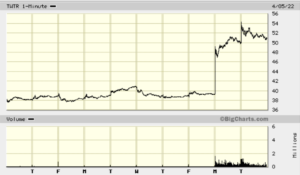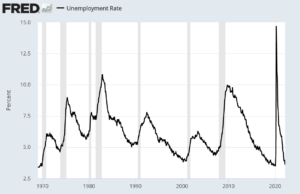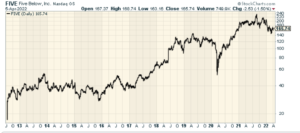CWS Market Review – April 5, 2022
(If you haven’t done so, please sign up for our premium newsletter. It’s $20 per month or $200 per year.)
Elon Musk Buys a Big Stake in Twitter
Earlier this week, Elon Musk announced that he had taken a 9.2% stake in Twitter (TWTR). According to SEC rules, you have to make your positions public if you buy more than 5% of a publicly-traded company. The market was euphoric. On Monday, shares of Twitter rallied nearly 30%.

Thanks to his big buy, Musk was given a seat on Twitter’s board of directors. That triggers another SEC rule. Musk can’t be the owner of more than 14.9% of Twitter’s stock until after his term on the board ends which is in 2024. Basically, that means that we shouldn’t expect Musk to bite off many more large pieces of Twitter.
Musk’s stake in Twitter may sound like a lot, but it’s “only” $3 billion. That’s pocket change for Musk. With a fortune of $267 billion, Musk is the wealthiest man in the world.
With Monday’s big rally, Musk is already sitting on a nice profit. In this case, the market’s reaction may be more than idle speculation. Don’t expect Musk to be a silent investor. Musk has talked about making changes to the social media site. He has criticized its willingness to ban some well-known individuals while going light on others. Musk even polled his followers to ascertain the popularity of an edit function. (Yep, it’s very popular.)
With this investment, there’s an odd dynamic at work. A mega-billionaire can quietly buy a stock and then make the news public and watch the market send the investment much higher. Of course, there aren’t many people who can move the market like that. Maybe Warren Buffett is the only other.
In the past, Musk has hinted that he may want to start a rival to Twitter. I suppose he thought buying the thing was the easiest path. Having a quarter of a trillion dollars opens some options.
I should say that in a strict numbers sense, Twitter is not a very profitable company. Last year, the company made a profit of 20 cents per share. The shares are currently around $51, which gives the stock a P/E ratio of roughly 250. That’s about 15 times what a normal company would go for.
Of course, Twitter is not a normal company. This gets to the heart of a matter that’s very difficult for securities analysis: how do you value a relatively new company that’s growing quickly but is not very profitable? Nonconventional businesses should be looked at in nonconventional ways. Personally, I avoid such stocks. It’s not that I’m not a fan of the companies, but I simply can’t see which stock will emerge as the winner.
If you had gone into a brokerage firm 40 years ago and boldly announced, “Computers are the future! That’s where I want to invest!,” the firm most likely would have recommended stocks like Wang and DEC. Probably IBM. Maybe Apple, but that would have been the oddball choice.
My point is that even if your thesis was correct and computers had indeed been the future, finding the winners would have been very difficult. There used to be 400 domestic automakers in the U.S., but it wasn’t long before the industry became known as the Big Three.
I think there’s great potential for Twitter, but the current model isn’t working. If there’s anyone who has the pull to make a big winner out of Twitter, it’s Musk. I wish him well.
Get Ready for Three Straight 0.5% Hikes
Tomorrow, the Federal Reserve will release the minutes from their last meeting. Of course, this was the meeting in which the Fed decided to raise interest rates for the first time since 2019.
My view is that the Fed is way behind the curve and it needs to be far more aggressive in fighting inflation. I’m not alone. James Bullard, the top guy at the St. Louis Fed, agrees. He cast the lone dissenting vote at the last meeting.
I have to explain something about the Fed’s minutes. They never use specific names. Instead, it’s an amazing study in the use of indefinite pronouns. “Some” said this. “Several” agreed that. “Few” countered with this.
The minutes can be difficult to decipher, but I want to see how worried the members are about inflation. The minutes are usually released three weeks after the Fed meeting. The next meeting will be in in four weeks.
For now, the futures market expects to see a 0.5% increase in May, another 0.5% increase in June and another 0.5% increase in July. That’s more aggressive than the Fed has been signaling.

On Friday, the government released the March jobs report. During the month, the U.S. economy created 431,000 net new jobs. That’s another good report. Wall Street had been expecting 490,000. The numbers for January and February were revised higher as well.
The unemployment rate fell to 3.6%. That’s another post-Covid low. It’s also lower than every single month from January 1970 through August 2019 (see chart above).
The broader U-6 rate fell to 6.9%. That’s just 0.1% above the all-time low from 2019, although that series only goes back to 1994.
One weak spot is that average hourly earnings grew by just 0.4%. In the last year, average hourly earnings are up 5.6% which is less than inflation. The next inflation report will be out next week. This report will also be the first one to feel the effects of the war in Ukraine.
Lael Brainard, who is President Biden’s pick to be the next vice-chair of the Fed, spoke today about the impact of inflation. She underscored an important point that inflation weighs heavily on lower-income consumers. She gave the example of a family that regularly buys a brand-name cereal. When inflation hits, they can easily go to store-brand cereal. But a low-income family that already buys the store-brand can’t make that switch. When inflation is running at 8%, it’s not 8% for everyone.
Speaking of finding a good bargain, let’s look at a retailer that’s thriving in the Age of Amazon.
Stock Focus: Five Below
In recent years we’ve heard a lot about the great “Retail Apocalypse,” and it’s true that Amazon has changed the game permanently for a lot of retailers. We’ve also seen the death spirals of once-mighty retailers like JC Penney and Sears and many others.
But not everyone is being done in by Bezos and his ubiquitous retail machine. One standout is the quirky Five Below (FIVE).
There’s something so elementary about Five Below that makes it brilliant. The concept is simple: They don’t sell anything for more than $5.
The store is specifically geared toward teens and pre-teens. Their tagline says it all: “hot stuff, cool prices.” Five Belows are also purposely located in strip malls. That helps keep the rent down.
They’ve hit onto something big. The company was founded in 2002 by David Schlessinger and Tom Vellios. These were the guys behind Zany Brainy.

The stock IPO’d ten years ago. Today, there are over 1,200 stores across 40 states. The company has very ambitious plans for growth. Five Below aims to triple its number of stores by end of fiscal 2030.
So what is it, exactly, that they sell? You name it. As long as it’s less than $5. They sell things like toys and games, or cheap accessories. A lot of it is tacky. A lot of it is silly. But it’s all well-planned.
Are you in the market for an inflatable furry ottoman? Well, Five Below has got you covered. A pink duffel bag? Yep, they’ve got that too.
The items aren’t supposed to be important. Instead, they’re supposed to fun impulse buys, but that’s the secret that sets them apart from Amazon. What Five Below shoppers like is the “treasure hunt” experience. A group of friends will spend time digging through their shelves. This is something Amazon can’t recreate online. By the way, the stores do have sections for $10 items.
Five Below knows their customers. They don’t come in looking for the item they’ll eventually buy. They want to spend time combing through dozens of items before selecting a final few. As odd as it may sound, they come for the Five Below experience.
Apparently, there’s a lot of business in $5 items. For the fiscal year ended in February, Five Below had sales of $2.85 billion. (That’s a lot of stuffed neon green hippos.) That’s also a 45% increase over the year before.
Silly stuff is serious business. Gross margins currently run around 36% which is quite good for a low-cost retailer. Operating margins are 12% and net margin comes in at just under 10%. That’s an efficient shop.
This is no small business either. Five Below currently has a market value of more than $9 billion and it’s a member of the S&P 400 Mid-Cap Index. The CEO summed it up perfectly: “We’re the T.J. Maxx for kids.”
Here’s what else I like. Five Below has a solid balance sheet. The firm doesn’t owe a dime in long-term debt. Make no mistake, the company got hit hard by the coronavirus lockdown. In June 2021, Five Below reported a fiscal Q1 loss of 91 cents per share.
That hurt but things are looking much better now. The gradual passing of Covid is also very good news for Five Below. Last week, Five Below reported fiscal Q4 earnings of $2.49 per share. That beat the Street by one penny per share. That was the seventh quarter in a row that Five Below beat the Street. For Q4, earnings grew by 13.2%. In times of inflation, consumers become more price sensitive which is good for Five Below.
Joel Anderson, President and CEO of Five Below, stated, “We were very pleased with our fourth quarter results that capped off a record year. We delivered sales growth in line with our expectations against the difficult comparison to last year’s stimulus-fueled comparable sales increase of 13.8%, and despite the impact of weather in January. The strength was broad-based, with Sports, Candy, Seasonal and Style worlds outperforming.”
Let’s look at guidance. For fiscal Q1, Five Below expects sales between $644 million and $658 million, and earnings between 54 and 62 cents per share. For the whole year, Five Below sees sales ranging between $3.16 billion and $3.26 billion, and earnings between $5.19 and $5.70 per share. That’s up from $4.95 per share last year. Frankly, the guidance is a bit lower than I expected.
Last summer, share of Five Below got $237. The stock has drifted lower since then. On Tuesday, it closed at $165.74 per share. That’s still a little high for me, but I’d be interested if Five Below goes below $140 per share. This off-beat retailer is one to watch.
That’s all for now. I’ll have more for you in the next issue of CWS Market Review.
– Eddy
Posted by Eddy Elfenbein on April 5th, 2022 at 9:09 pm
The information in this blog post represents my own opinions and does not contain a recommendation for any particular security or investment. I or my affiliates may hold positions or other interests in securities mentioned in the Blog, please see my Disclaimer page for my full disclaimer.
- Tweets by @EddyElfenbein
-
-
Archives
- May 2024
- April 2024
- March 2024
- February 2024
- January 2024
- December 2023
- November 2023
- October 2023
- September 2023
- August 2023
- July 2023
- June 2023
- May 2023
- April 2023
- March 2023
- February 2023
- January 2023
- December 2022
- November 2022
- October 2022
- September 2022
- August 2022
- July 2022
- June 2022
- May 2022
- April 2022
- March 2022
- February 2022
- January 2022
- December 2021
- November 2021
- October 2021
- September 2021
- August 2021
- July 2021
- June 2021
- May 2021
- April 2021
- March 2021
- February 2021
- January 2021
- December 2020
- November 2020
- October 2020
- September 2020
- August 2020
- July 2020
- June 2020
- May 2020
- April 2020
- March 2020
- February 2020
- January 2020
- December 2019
- November 2019
- October 2019
- September 2019
- August 2019
- July 2019
- June 2019
- May 2019
- April 2019
- March 2019
- February 2019
- January 2019
- December 2018
- November 2018
- October 2018
- September 2018
- August 2018
- July 2018
- June 2018
- May 2018
- April 2018
- March 2018
- February 2018
- January 2018
- December 2017
- November 2017
- October 2017
- September 2017
- August 2017
- July 2017
- June 2017
- May 2017
- April 2017
- March 2017
- February 2017
- January 2017
- December 2016
- November 2016
- October 2016
- September 2016
- August 2016
- July 2016
- June 2016
- May 2016
- April 2016
- March 2016
- February 2016
- January 2016
- December 2015
- November 2015
- October 2015
- September 2015
- August 2015
- July 2015
- June 2015
- May 2015
- April 2015
- March 2015
- February 2015
- January 2015
- December 2014
- November 2014
- October 2014
- September 2014
- August 2014
- July 2014
- June 2014
- May 2014
- April 2014
- March 2014
- February 2014
- January 2014
- December 2013
- November 2013
- October 2013
- September 2013
- August 2013
- July 2013
- June 2013
- May 2013
- April 2013
- March 2013
- February 2013
- January 2013
- December 2012
- November 2012
- October 2012
- September 2012
- August 2012
- July 2012
- June 2012
- May 2012
- April 2012
- March 2012
- February 2012
- January 2012
- December 2011
- November 2011
- October 2011
- September 2011
- August 2011
- July 2011
- June 2011
- May 2011
- April 2011
- March 2011
- February 2011
- January 2011
- December 2010
- November 2010
- October 2010
- September 2010
- August 2010
- July 2010
- June 2010
- May 2010
- April 2010
- March 2010
- February 2010
- January 2010
- December 2009
- November 2009
- October 2009
- September 2009
- August 2009
- July 2009
- June 2009
- May 2009
- April 2009
- March 2009
- February 2009
- January 2009
- December 2008
- November 2008
- October 2008
- September 2008
- August 2008
- July 2008
- June 2008
- May 2008
- April 2008
- March 2008
- February 2008
- January 2008
- December 2007
- November 2007
- October 2007
- September 2007
- August 2007
- July 2007
- June 2007
- May 2007
- April 2007
- March 2007
- February 2007
- January 2007
- December 2006
- November 2006
- October 2006
- September 2006
- August 2006
- July 2006
- June 2006
- May 2006
- April 2006
- March 2006
- February 2006
- January 2006
- December 2005
- November 2005
- October 2005
- September 2005
- August 2005
- July 2005
 Eddy Elfenbein is a Washington, DC-based speaker, portfolio manager and editor of the blog Crossing Wall Street. His
Eddy Elfenbein is a Washington, DC-based speaker, portfolio manager and editor of the blog Crossing Wall Street. His